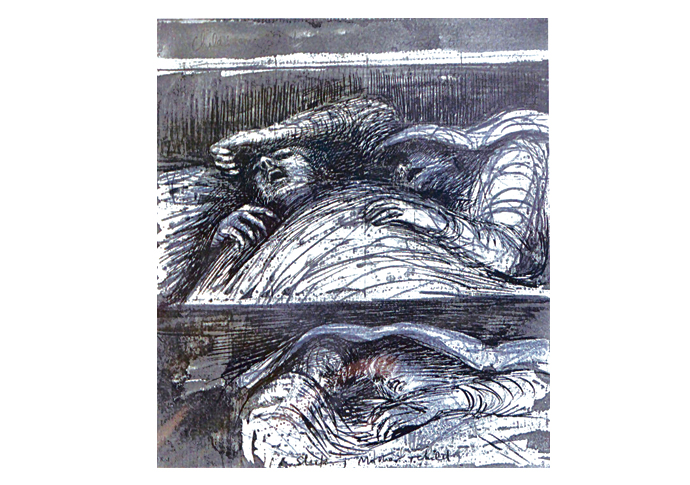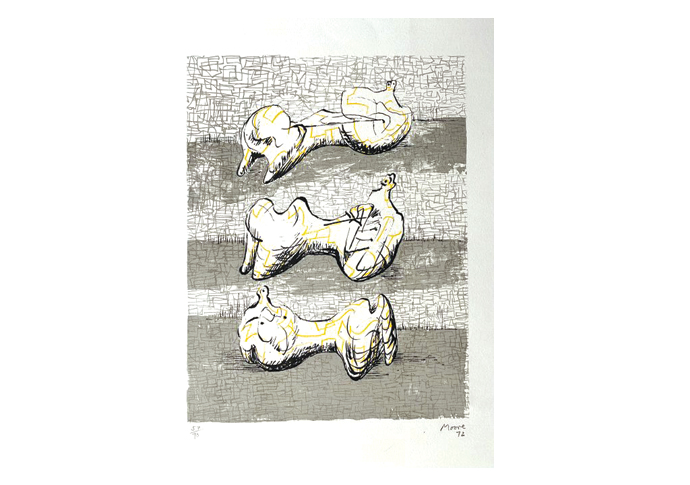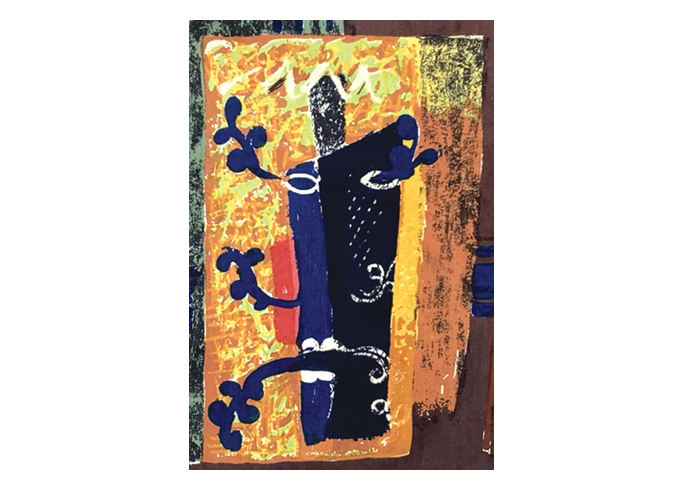How artists captured the nation during its darkest hours
A new exhibition of the works of Henry Moore and John Piper opens next month. Dan Carrier talks to the man behind it
Friday, 26th September 2025 — By Dan Carrier

Henry Moore’s Shelter 4
THEIR heads rested on rolled-up coats, feet stuck out the end of blankets. Thousands of Londoners descended every night into the tube to try and find a safe place to sleep as Nazi bombers flew overhead.
And as the Blitz raged above, artist Henry Moore quietly sat on station platforms and captured what he saw.
Now a new exhibition in Marylebone offers the chance to see some of Moore’s preliminary sketches made during the Blitz at Belsize Park’s tube station: and alongside the Moore works are pieces by his contemporary John Piper, who was also commissioned to capture the nation during its darkest hours.
Mid-century art dealers Fifties Art have put together the exhibition.
The dealer’s founder Dr Richard Turkington began collecting mid-century British art 10 years ago, and was originally drawn to it as he recognised post-war realism from his own upbringing.
An academic who specialised in researching housing need, he found himself drawn into the art world when he saw a painting for sale.
“I bought one painting from the 1950s called Railway Sidings, Bradford,” he remembers.

Moore’s Three Reclining Figures
“When I was a kid I was a trainspotter and perhaps because of, rather in spite of, its deadpan title, this painting really caught my eye. I grew up between Leeds and Wakefield, so it was a scene I could recognise.
“Buying this one painting made me question whether it was typical for people to paint everyday things.”
This then prompted a visit to an art auction of similar works.
“I got this idea that perhaps I could become a specialist in mid-century art,” he says.
“I had no background in art and had no idea how this would work but I became fascinated by the mid-century art – be it ceramics, paintings or prints.”
He has now organised 25 exhibitions in a decade, focusing on works from the 1930s through to the 1970s.
He has a particular interest in the works of Piper, known for both paintings as well as stained glass, ceramics and print-making.
“In the immediate post-war period there were two trends,” he says. “One was about the post-war reconstruction – there was a new belief in democracy and a new idea that things should be widely accessible to all – including art.
“Young artists came out of the war with the aim of capturing the everyday. You had the likes of the East London group, who did not want to be seen as exclusive or associated with the rich. They wanted to capture everyday life and make their work widely available. It helped create a golden era of British art.”
This was not exclusively left to painters of townscapes: it seeped into all forms of visual art.

John Piper’s Foliate Heads fabric panel
“There was, for example, in the 1950s a massive revival of print-making,” adds Dr Turkington. “You could create multiple copies of images and make them accessible to everyone.”
Dr Turkington’s collection reflects his own interest in the post-war art movements. He notes how British artists played an important role recording the nation at war – how they responded to peace.
While some moved towards abstraction – such as Moore’s sculptural pieces – others sought a return to realism, both in style and subject matter: capturing the everyday, from the interiors of homes to the nation at work through industrial imagery.
For Dr Turkington, this style and form of 1950s art reflects his upbringing.
“My family comes from a working-class background in the north of England,” he says.
“They worked in mills or pits. My grandfather was a powerful influence on my interests – he was a miner, a trade unionist, a Labour councillor.
“There was that meeting of the cultural and political in industrial communities.”
Groups such as the Pitman Painters – working-class art students from the Durham region who honed their talents at night school – and the East London school were products of this.
As Nazi Germany launched its murderous bombing campaign, Moore was living in Belsize Park and had been commissioned, along with other artists, to work for the government, capturing the nation’s struggle.

Piper’s The Seasons – Summer
Moore decided to record the nightly trudge to the nearest tube station as Londoners sought shelter.
“Moore was commissioned by the War Artists’ Committee and he suggested this topic,” says Dr Turkington. “He went to Belsize Park and Hampstead stations just with a sketchbook.
“He went into shelters during the Blitz and he did primarily sketches of people.”
In 1967, Marylebone Fine Art dealers produced copies of his 1940-1941 sketchbooks.
“In the spirit of post-war reconciliation, they made English, German and Italian editions,” adds Dr Turkington.
“They were made up of 80 prints and they produced 180 of them in total. I bought an edition numbered 22 of 180, signed by Moore, from a German art dealer.”
Dr Turkington owns 71 of the prints.
“There are themes: some are panoramic views down platform or along a station,” he says.
“Many feature sleeping figures. He captured these hidden forms under coats and blankets. Some of the sketches are marked up, they are squared up as if they are sketched out on graph paper – it is an artistic technique to create a sense of perspective and proportion.
“Some have Moore’s handwritten notes on them. You can see they are his working notes. He writes ‘people looking uncomfortable here’ and ‘very stiff’, for example. Some have multiple figures while others are sketched boxes to give an idea of perspective and scale.”
A selection of the prints will be on display.
“I was just blown away when I first saw them,” he adds. “They are very moving.”
As well as using the sketches as the basis for larger works completed in his studio in Upper Park Road, Moore published his Shelter Sketchbook, a collection from 1940.
“It shows how people saw the significance of what was happening,” Dr Turkington adds.
“Paper and printing was rationed but this was allowed to be produced as an A5 landscape edition.”
The show also includes works by Piper, who captured the devastation caused by the Blitz.
When Coventry was bombed, Piper visited in the immediate aftermath. He would later be commissioned to design the stained glass windows when a new cathedral was built.
The show includes original screen prints, lithographs and paintings by Piper.
They illustrate his interest in abstract work.
“Piper said he had moved away from abstract art in the 1930s but that wasn’t strictly true,” says Dr Turkington.
“He included abstract elements in his work. He designed, for example, fabrics.”
And when Moore’s sketchbooks are considered, the signs of his move into large, abstract sculptural figures makes sense.
“The sketchbooks were instrumental as he developed his sculptural forms,” adds Dr Turkington. “It was like an experimental ground for creating sculptural forms which he produced during the remaining decades of his life. It is a lesson into how artists work.
“He saw humans in this sculptural form – bundles of figures with babies and blankets and clothes and bundles all around them.
“He then took it further – he notes the detail of the human form and works with the shapes created.”
• Making Connections: Abstraction and Modern British Art, presented by Fifties Art runs from October 21-27, 11am-5pm, at 67 York Street Gallery, W1H 1QB. See https://67yorkstreetgallery.com/blogs/upcoming-exhibitions/making-connections-abstraction-modern-british-art